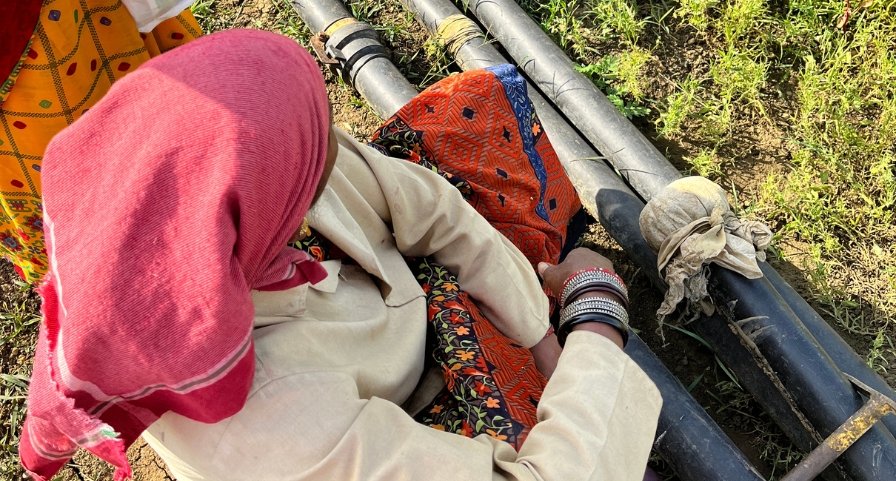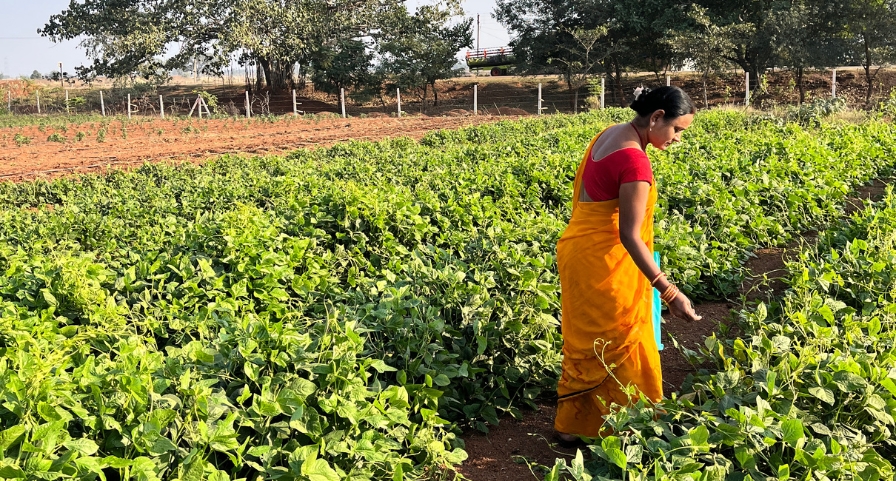Lakshmi Patel from a small village called Hasda in Dhamdha block of Durg District, Chhattisgarh, has three acres of land, where she and her family grow paddy and vegetables like cabbage, cauliflower, tomatoes, and brinjal. They are one of the few households in the village with a borewell. Because of the ample availability of water, they grow multiple crops annually and earn decent returns at the mandi (wholesale market).
I go on rounds to the villages nearby and the women there listen to what I have to say. However, the men in their families prevent them from implementing what they’re learnt from me.

Lakshmi is in her mid-thirties. She knows all that needs to be done in the field, including weeding, mulching, and spraying neem water and pesticides. She remembers the schedule of various activities after sowing or gaps to be given between applications, like ensuring spraying of neem water every ten days for crop protection. But when asked about the rationale behind these activities, she laughs and pulls at the sari covering her head.
“Why do we need to know all this? We do whatever they tell us to do,” she says, gesturing towards her husband and father-in-law.
Another farmer, some 20 kilometres away within the same block, Meera Bai, is not as fortunate as Lakshmi. Due to the lack of a borewell and with just a half-acre of landholding, she and her family work as agricultural labourers in one of the large farms that have cropped up close to the highway. While the farm provides employment, the superior quality of the produce creates competition in the mandi between small and large farmers. Due to this, farmers like Meera Bai and her husband abandon their land and resort to labour work for an assured income.
Meera Bai does all types of work, from soil and seed preparation, sowing, tending to the crops, irrigating the fields, to harvesting the produce. She does as she is told and has eventually learnt what needs to be done and at what point. But when asked to identify a particular disease in tomato, a crop she has dealt with for nearly a decade, she gives a reaction similar to Lakshmi’s. She laughs and turns away. All she needs to do is check for a few symptoms and report them to the landowners. Then she is instructed on what to spray.
Also read: Rural women farmers plough their way to financial freedom
The gender gap in agriculture
As per the Annual Periodic Labour Force Survey (PLFS) Report 2023–24, 64.4 percent of the female workforce in India works in agriculture. Interestingly, the workforce participation rate for rural females is significantly higher than the urban women participation rate. Even though cooking and looking after the nutritional needs of children are primarily the responsibility of women, they have limited say in what will be grown in the household fields and kitchen gardens.

Conventionally, women are not considered farmers. In fact, they seldom call themselves farmers. Due to factors like societal conditioning, lower levels of education, domestic responsibilities, and lack of time and mobility to access extension services, women are pushed to the background.
While talking to family members, another reason that stood out was that since women are mostly not a part of the marketing process, they don’t need to be a part of such discussions. There is also an unspoken assumption that they would not be able to understand such conversations.
These factors manifest as implementation-impact gaps for the various government schemes focused on training women farmers. Government extension facilities and departments prefer farmers to visit their premises for training, especially multi-day ones, which is a constraint for many women with time, mobility, and family restrictions.
Where government officers or scientists do visit fields to impart training, the presence of a large number of men hinders women farmers from comfortably speaking up.
Community leaders paving the way
While solutions are being developed for improving access to information, there is another obstacle. Vijaya is a krishi sakhi (farmer friend) from another panchayat in Durg district. Krishi sakhis are a network of women, trained in agri-related topics as part of State Rural Livelihood Missions (SRLM), who provide agricultural support to the women of their villages.
Also read: ‘Soilless’ farming bears fruit for Odisha women farmers

While this model intends to increase awareness among women farmers, the krishi sakhis face a major issue: lack of adoption of their teachings. Though women understand the concepts taught, most don’t adopt them even when they want to, due to resistance from their households.
Vijaya doesn’t have land of her own, and spends most of her time helping women. She said, “I go on rounds to the villages nearby and the women there listen to what I have to say. However, the men in their families prevent them from implementing what they’re learnt from me.”
In some villages, these women even go door-to-door suggesting natural farming methods like the application of neem and Jeevamruth. Still, it’s a challenge for them to find a willing audience.
The only place where women farmers do speak up is within self-help group (SHG) meetings or in the informal classes held by the krishi sakhis. And what happens in these meetings is profound. Women confidently discuss the merits and demerits of natural farming, reducing water table levels, and improving access to markets. However, these are limited to women’s groups and institutions. The systemic undervaluation of their knowledge and opinions is still an obstacle.

With a deeper understanding of these issues, it will be possible to design solutions to bring women into mainstream agricultural discussions. The work has started but we still have a long way to go before every woman working on a field proudly calls herself a farmer.
Also read: Women farmers go extra mile in Assam
The lead image on top depicts krishi sakhi Vijaya showing around the community kitchen garden maintained by a SHG of her village. (Photo by Shaurya Sharma)
Shaurya Sharma is a development worker, artist, architect, and an aspiring writer. Currently, she is based in Kabirdham, Chhattisgarh, working as a Public Policy in Action (PPiA) fellow with the district administration.






